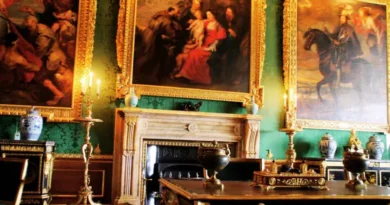How Many Bodies Are Buried in Windsor Castle?
Calculating the total number of burials is unfeasible due to the vast span of human history and the lack of comprehensive records, especially for ancient times. Additionally, natural decomposition and the repurposing of burial sites over millennia have erased many traces of past interments.
Windsor Castle has many burials, specifically St George’s Chapel, located within the castle grounds, is the burial site of several British monarchs and royal family members. Currently, 11 kings and queens are buried in St George’s Chapel, including notable monarchs like King Henry VIII, Charles I, and Queen Elizabeth II.
Additionally, beneath St George’s Chapel is the Royal Vault, where around 25 royals are interred, including temporary burials such as that of Prince Philip, Duke of Edinburgh, until his final resting place was prepared.
Let’s discuss in detail:
Introduction
Windsor Castle, a historic royal residence in Berkshire, England, is one of the most significant sites of British history and heritage. Beyond its role as a royal residence and a symbol of British monarchy, Windsor Castle is also notable for its numerous royal burials. These burials span centuries and include monarchs, consorts, and other royal family members. This article provides a detailed look at the various burial sites within Windsor Castle. The individuals interred there covered key locations such as the Altar, the Quire, the Royal Vault, the King George VI Memorial Chapel, the Albert Memorial Chapel, the Gloucester Vault, and other notable burials.

Burials at the Altar of St George’s Chapel
The Altar of St George’s Chapel is one of the primary burial locations within Windsor Castle. This area contains the remains of several significant figures from British history:
- George Plantagenet, Duke of Bedford (1479): George Plantagenet was the son of Edward IV and Elizabeth Woodville. He died young, at just two years old, and was buried in St George’s Chapel in 1479.
- Mary of York (1482): Another child of Edward IV and Elizabeth Woodville, Mary of York, was buried here in 1482, having died at a young age as well.
- Edward IV, King of England (1483): Edward IV, a major figure in the Wars of the Roses, was buried at the Altar of St George’s Chapel after his death in 1483. He was the first King of England to be buried in this chapel.
- Henry VI, King of England (1484): Initially buried at Chertsey Abbey, King Henry VI’s body was later reburied at St George’s Chapel in 1484 by Richard III. Henry VI was a rival to Edward IV during the Wars of the Roses and his reburial in the chapel of his enemy signifies a significant moment in English history.
- The Princes in the Tower: The coffins of two unidentified children believed to be Edward V, King of England, and Richard of Shrewsbury, Duke of York, who were famously known as the Princes in the Tower, were also placed near the altar. The princes were sons of Edward IV and Elizabeth Woodville.
- Elizabeth Woodville, Queen of England (1492): Elizabeth Woodville, the widow of Edward IV, was buried here in 1492. Her burial in St George’s Chapel further solidified the site as a royal resting place.
- Princess Louise of Saxe-Weimar-Eisenach (1832): Niece of Queen Adelaide, Princess Louise was buried at the altar in 1832. Her inclusion here shows the continued use of the chapel as a burial place for extended royal family members.
- Edward VII, King of the United Kingdom (1910): Originally interred in the Royal Vault, Edward VII was later moved to the altar area in 1910. Edward VII was the son of Queen Victoria and Prince Albert and was a pivotal figure in early 20th-century British history.
- Alexandra of Denmark, Queen of the United Kingdom (1925): The wife of Edward VII, Alexandra of Denmark, was also originally interred in the Royal Vault before being moved to the altar area. Her burial beside her husband reflects their shared roles as monarchs and consort.
Burials in the Quire of St George’s Chapel

The Quire of St George’s Chapel, another significant burial area within Windsor Castle, is known for its historical importance and the notable figures interred there:
- Jane Seymour, Queen of England (1537): Jane Seymour, the third wife of Henry VIII and the only one of his wives to receive a queen’s burial, is interred in the Quire. She was buried here following her death shortly after giving birth to Henry’s long-desired male heir, Edward VI.
- Henry VIII, King of England and Ireland (1547): One of the most famous English monarchs, Henry VIII, is buried in the Quire alongside Jane Seymour. His burial in 1547 marked the end of a tumultuous reign that saw the break from the Catholic Church and the establishment of the Church of England.
- Charles I, King of England, Scotland, and Ireland (1649): Following his execution in 1649 during the English Civil War, Charles I was buried in the Quire of St George’s Chapel. His burial here reflects the restoration of the monarchy under his son, Charles II, who chose to bury his father in this significant location.
- Stillborn son of Anne, Queen of Great Britain (1698): The stillborn son of Anne, Queen of Great Britain, and Prince George of Denmark is also buried in the Quire, demonstrating the tradition of burying royal offspring within the chapel, regardless of their having died in infancy.
Burials in the Royal Vault
The Royal Vault beneath St George’s Chapel serves as a temporary or permanent resting place for many members of the British royal family:
- Princess Amelia of the United Kingdom (1810): Amelia was the youngest daughter of King George III and Queen Charlotte of Mecklenburg-Strelitz. She passed away at the age of 27 after suffering from tuberculosis and was buried in the Royal Vault.
- Princess Augusta of Great Britain, Duchess of Brunswick-Lünenburg (1813): Augusta was the elder daughter of Frederick, Prince of Wales, and Princess Augusta of Saxe-Gotha-Altenburg. She was buried in the Royal Vault after her death in 1813.
- Princess Charlotte of Wales (1817): The only daughter of George IV and Caroline of Brunswick-Wolfenbüttel, Charlotte was the heir presumptive to the British throne. She died tragically at the age of 21 following childbirth and was buried in the Royal Vault.
- Stillborn Son of Princess Charlotte of Wales and Prince Leopold of Saxe-Coburg-Saalfeld (1817): The stillborn son of Princess Charlotte and Prince Leopold was also buried in the Royal Vault alongside his mother.
- Charlotte of Mecklenburg-Strelitz, Queen of the United Kingdom and Hanover (1818): The wife of King George III, Queen Charlotte, died in 1818 and was buried in the Royal Vault. She was a prominent queen consort known for her patronage of the arts and for having a large family with George III.
- Stillborn Daughter of Ernest Augustus, King of Hanover, and Frederica of Mecklenburg-Strelitz (1818): The stillborn daughter of Ernest Augustus and Frederica was interred in the Royal Vault in 1818.
- George III, King of the United Kingdom and Hanover (1820): King George III, who reigned for 59 years and saw the American Revolution and the Napoleonic Wars, was buried in the Royal Vault after his death in 1820.
- Prince Edward, Duke of Kent and Strathearn (1820): The father of Queen Victoria, Prince Edward, was the fourth son of George III and Charlotte of Mecklenburg-Strelitz. He was buried in the Royal Vault after his death in 1820.
- Prince Alfred of Great Britain (1820, reburial): Alfred, the ninth son of George III and Charlotte of Mecklenburg-Strelitz, died as a child. His remains were transferred to the Royal Vault in 1820.
- Prince Octavius of Great Britain (1820, reburial): Another son of George III and Charlotte of Mecklenburg-Strelitz, Octavius also died in childhood. He was reburied in the Royal Vault in 1820.
- Princess Elizabeth of Clarence (1821): The daughter of William IV and Adelaide of Saxe-Meiningen, Elizabeth died in infancy and was buried in the Royal Vault.
- Prince Frederick, Duke of York and Albany (1827): The second son of George III and Charlotte of Mecklenburg-Strelitz, Prince Frederick served as Commander-in-Chief of the British Army. He was buried in the Royal Vault in 1827.
- George IV, King of the United Kingdom and Hanover (1830): George IV, who reigned from 1820 to 1830, was the son of George III and Charlotte of Mecklenburg-Strelitz. He was known for his extravagant lifestyle and was buried in the Royal Vault in 1830.
- William IV, King of the United Kingdom and Hanover (1837): The third son of George III and Charlotte of Mecklenburg-Strelitz, William IV became king in 1830 and was buried in the Royal Vault after his death in 1837.
- Princess Augusta Sophia of the United Kingdom (1840): Augusta Sophia was the sixth daughter of George III and Charlotte of Mecklenburg-Strelitz. She died in 1840 and was buried in the Royal Vault.
- Adelaide of Saxe-Meiningen, Queen of the United Kingdom and Hanover (1849): The wife of William IV, Queen Adelaide, was a beloved consort who was known for her charitable works. She was buried in the Royal Vault in 1849.
- George V of Hanover (1878): The grandson of George III and Charlotte of Mecklenburg-Strelitz, George V of Hanover was a king who reigned over Hanover until it was annexed by Prussia. He was buried in the Royal Vault in 1878.
- Baroness Victoria von Pawel-Rammingen (1881): Victoria, the daughter of Princess Frederica of Hanover and Alphons, Baron von Pawel-Rammingen, was buried in the Royal Vault in 1881.
- Princess Mary Adelaide of Cambridge, Duchess of Teck (1897): Known as the “People’s Princess,” Mary Adelaide was the mother of Queen Mary, the wife of George V. She was buried in the Royal Vault in 1897.
- Francis, Duke of Teck (1900): The husband of Princess Mary Adelaide of Cambridge and the father of Queen Mary, Francis was buried in the Royal Vault in 1900.
- Princess Frederica of Hanover, Baroness von Pawel-Rammingen (1926): The daughter of George V, King of Hanover, and Marie of Saxe-Altenburg, Frederica was buried in the Royal Vault in 1926.
- Prince Adolphus, Duke of Cambridge (1930, reburial): The seventh son of George III and Charlotte of Mecklenburg-Strelitz, Adolphus served in the British Army and was reburied in the Royal Vault in 1930.
- Princess Augusta of Hesse-Kassel, Duchess of Cambridge (1930, reburial): The wife of Prince Adolphus, Duchess Augusta, was reburied in the Royal Vault alongside her husband in 1930.
These burials span from the early 19th century to the early 20th century, showcasing the Royal Vault’s continued importance as a resting place for members of the British royal family.

Burials Near the West Door
The area near the West Door of St George’s Chapel also contains several notable burials:
- George V, King of the United Kingdom (1936): Originally interred in the Royal Vault, George V was later moved near the West Door in 1936. His burial here marks the transition from one era to the next, as he was succeeded by his son, Edward VIII, who abdicated the throne in 1936.
- Mary of Teck, Queen of the United Kingdom (1953): The wife of George V, Mary of Teck, was buried near the West Door in 1953, reflecting the royal tradition of burying spouses near each other.
Burials in the King George VI Memorial Chapel
The King George VI Memorial Chapel within St. George’s Chapel is the final resting place for several key members of the British royal family. Here are the notable burials:
- George VI, King of the United Kingdom (1895–1952): King George VI was initially interred in the Royal Vault on 15 February 1952 after his death. He was later moved to the newly constructed King George VI Memorial Chapel on 26 March 1969.
- Princess Margaret, Countess of Snowdon (1930–2002): Princess Margaret, the younger daughter of King George VI and Queen Elizabeth, had her ashes buried in the memorial chapel following her cremation in Slough in 2002.
- Elizabeth (née Bowes-Lyon), Queen of the United Kingdom (1900–2002): Known as the Queen Mother, Elizabeth was the wife of King George VI. She was laid to rest in the chapel in 2002, next to her husband.
- Prince Philip, Duke of Edinburgh (1921–2021): Prince Philip, the husband of Queen Elizabeth II, was initially interred in the Royal Vault in 2021. Following the death of his wife, Queen Elizabeth II, in 2022, his remains were moved to the King George VI Memorial Chapel.
- Elizabeth II, Queen of the United Kingdom (1926–2022): Queen Elizabeth II, the longest-reigning monarch in British history, was buried in the chapel in 2022 alongside her parents, sister, and husband.
Burials in the Albert Memorial Chapel
The Albert Memorial Chapel is another significant burial site within St. George’s Chapel:
- Prince Leopold, Duke of Albany (1853–1884): Leopold, the youngest son of Queen Victoria and Prince Albert, was first laid to rest in the Royal Vault. His remains were later moved to the Albert Memorial Chapel.
- Prince Albert Victor, Duke of Clarence and Avondale (1864–1892): Prince Albert Victor, the eldest son of King Edward VII and Queen Alexandra, was also initially interred in the Royal Vault and subsequently moved to the Albert Memorial Chapel.
Burials in the Gloucester Vault
The Gloucester Vault houses the remains of several members of the Gloucester family:
- Prince William Henry, Duke of Gloucester and Edinburgh (1743–1805): The son of Frederick, Prince of Wales, and Princess Augusta of Saxe-Gotha, Prince William Henry was interred here in 1805.
- Maria (née Walpole), Duchess of Gloucester and Edinburgh (1736–1807): Maria, the wife of Prince William Henry, was laid to rest in the Gloucester Vault two years after her husband.
- Prince William Frederick, Duke of Gloucester and Edinburgh (1776–1834): The son of Prince William Henry and Maria, he was buried in the vault in 1834.
- Princess Sophia of Gloucester (1773–1844): Princess Sophia, daughter of Prince William Henry and Maria, was interred here in 1844.
- Princess Mary of the United Kingdom, Duchess of Gloucester and Edinburgh (1776–1857): Daughter of King George III and wife of Prince William Frederick, she was buried in the Gloucester Vault in 1857.
Other Notable Burials
Several other notable individuals are buried in different areas of St. George’s Chapel:
- William Hastings, 1st Baron Hastings: A close friend of King Edward IV, he is buried in the north aisle of the chapel.
- Anne Manners (née St Leger), Baroness de Ros: The niece of King Edward IV and Richard III, Anne is buried in the private Rutland Chapel.
- George Manners, 11th Baron de Ros: Husband of Anne St Leger, he is also buried in the Rutland Chapel.
- Charles Brandon, 1st Duke of Suffolk (1545): Charles, the second husband of Mary Tudor, was buried in St. George’s Chapel in 1545.
- Christopher Villiers, 1st Earl of Anglesey (1631): He was buried in St. George’s Chapel in 1631.
- Henry Somerset, 1st Duke of Beaufort: He and his ancestors are buried in the private Beaufort Chapel. The original monument was moved to St Michael and All Angels Church, Badminton, in 1878.
- Peniston Booth, Dean of Windsor: A former dean of Windsor, Booth is interred in the chapel.
- Lieutenant-General Sir John Elley: A commoner who distinguished himself at the Battle of Waterloo, he is buried in the north quire aisle.
- Dejazmatch Alemayehu Tewodros (1879): Alemayehu, son of Tewodros II, Emperor of Ethiopia, was buried at St. George’s Chapel on 21 November 1879.
Former Burials

Several burials have been moved from St. George’s Chapel over the years:
- Princess Victoria of Saxe-Coburg-Saalfeld, Duchess of Kent and Strathearn (1861): The mother of Queen Victoria, originally interred here, was later moved to the Duchess of Kent’s Mausoleum.
- Prince Albert of Saxe-Coburg and Gotha (1861): The husband of Queen Victoria was initially buried here but later moved to the Frogmore Royal Mausoleum.
- Prince Harald of Schleswig-Holstein (1876): Originally buried in St. George’s Chapel, his remains were moved to the Frogmore Royal Burial Ground in 1928.
- Prince Francis of Teck (1910): The brother of Queen Mary of Teck, initially interred here, was later moved to the Frogmore Royal Burial Ground.
- Alexander Duff, 1st Duke of Fife (1912): Initially buried here, his remains were moved to St Ninian’s Chapel, Braemar, later that year.
- Princess Louise Margaret of Prussia, Duchess of Connaught and Strathearn (1917): Initially interred in the chapel, her remains were moved to the Frogmore Royal Burial Ground in 1928.
- Prince Christian of Schleswig-Holstein (1917): Husband of Princess Helena of the United Kingdom, his remains were also moved to the Frogmore Royal Burial Ground in 1928.
- Lord Leopold Mountbatten (formerly Prince Leopold of Battenberg) (1922): Initially buried in St. George’s Chapel, his remains were moved to the Frogmore Royal Burial Ground in 1928.
- Princess Helena of the United Kingdom, Princess Christian of Schleswig-Holstein (1923): Initially interred in the chapel, her remains were moved to the Frogmore Royal Burial Ground in 1928.
- Lieutenant-Colonel Adolphus Cambridge, 1st Marquess of Cambridge (formerly Adolphus, Duke of Teck) (1927): His remains were moved to the Frogmore Royal Burial Ground in 1928.
- Rupert Cambridge, Viscount Trematon (formerly Prince Rupert of Teck) (1928): Initially buried in St. George’s Chapel, his remains were moved to the Frogmore Royal Burial Ground later that year.
- Louise, Princess Royal and Duchess of Fife (1931): Originally interred here, her remains were moved to St Ninian’s Chapel, Braemar, later that year.
- Princess Victoria of the United Kingdom (1935): Her remains were moved to the Frogmore Royal Burial Ground in 1936.
- Prince Arthur of Connaught (1938): Initially interred in the chapel, his remains were moved to the Frogmore Royal Burial Ground in 1939.
- Princess Louise of the United Kingdom, Duchess of Argyll (1939): Her ashes were initially interred in the chapel and later moved to the Frogmore Royal Burial Ground in 1940.
- Prince Arthur, Duke of Connaught and Strathearn (1942): His remains were moved to the Frogmore Royal Burial Ground in 1942.
- Prince George, Duke of Kent (1942): Initially buried here, his remains were moved to the Frogmore Royal Burial Ground in 1968.
- Princess Beatrice of the United Kingdom, Princess Henry of Battenberg (1944): Her remains were moved to St Mildred’s Church, Whippingham, in 1945.
- Princess Helena Victoria of Schleswig-Holstein (1948): Initially interred in the chapel, her remains were moved to the Frogmore Royal Burial Ground in 1948.
- Princess Marie Louise of Schleswig-Holstein (1956): Her remains were moved to the Frogmore Royal Burial Ground in 1957.
- Major-General Alexander Cambridge, 1st Earl of Athlone (1957): Initially interred here, his remains were moved to the Frogmore Royal Burial Ground later that year.
- Princess Alice of Battenberg, Princess Andrew of Greece and Denmark (1969): Originally buried in the chapel, her remains were moved to the Church of Mary Magdalene in Jerusalem in 1988.
St. George’s Chapel remains a significant burial site for the British royal family, reflecting its deep historical and cultural heritage.
FAQ
How many monarchs are buried in St George’s Chapel?
St George’s Chapel at Windsor Castle is the final resting place of 11 British monarchs, making it one of the most significant royal burial sites in the United Kingdom. Notably, eleven sovereigns are interred there, including Edward IV, Henry VI, Henry VIII, Charles I, George III, George IV, William IV, Edward VII, George V, George VI, and Elizabeth II.
Who was the first monarch buried at Windsor Castle?
King Edward IV, who died in April 1483, was the first monarch to be buried at Windsor Castle, with his interment taking place in St. George’s Chapel. Although King Henry VI was reburied at Windsor in 1484, Edward IV’s burial preceded this event.
Is Queen Elizabeth II buried at Windsor Castle?
Yes, Queen Elizabeth II was interred in the King George VI Memorial Chapel, part of St George’s Chapel, following her death in 2022. She was buried alongside her husband, Prince Philip, her parents, King George VI and Queen Elizabeth The Queen Mother, and her sister, Princess Margaret, in the Royal Vault at Windsor Castle.
Where is Prince Philip buried?
Following Prince Philip’s death on April 9, 2021, he was initially interred in the Royal Vault beneath St. George’s Chapel. After the death of Queen Elizabeth II in 2022, his remains were moved to the King George VI Memorial Chapel within St. George’s Chapel to rest beside her.
Are there any unidentified remains in St George’s Chapel?
The chapel contains the coffins of two unidentified children, believed to be the Princes in the Tower—Edward V, King of England, and Richard of Shrewsbury, Duke of York—sons of Edward IV and Elizabeth Woodville.
Which queens are buried at Windsor Castle?
Several queens are interred at Windsor Castle’s St George’s Chapel. Queen Elizabeth II was laid to rest in the King George VI Memorial Chapel in St George’s Chapel in 2022, alongside her husband, Prince Philip, Duke of Edinburgh. Her mother, Queen Elizabeth, the Queen Mother, was also buried there in 2002. Additionally, Queen Mary, consort of George V, was interred in St George’s Chapel in 1953. Earlier burials include Queen Jane Seymour, third wife of Henry VIII, who was interred in 1537, and Queen Alexandra, consort of Edward VII, buried in 1925. These interments highlight Windsor Castle’s long-standing role as a royal mausoleum.
Is Henry VIII buried at Windsor Castle?
Yes, King Henry VIII is buried at Windsor Castle. Following his death on January 28 1547, he was interred in St George’s Chapel on February 16 1547, alongside his third wife, Jane Seymour. Although Henry had planned a grand tomb for himself, it was never completed, and his burial site is marked by a simple ledger stone in the Quire of the chapel. Later, King Charles I was also interred in the same vault.
Are there any non-royals buried in St George’s Chapel?
Yes, several non-royals are interred in St George’s Chapel at Windsor Castle. Notable individuals include William Hastings, 1st Baron Hastings, a close confidant of King Edward IV, buried in the north aisle; Anne Manners (née St Leger), Baroness de Ros, niece of Edward IV and Richard III, interred alongside her husband, George Manners, 11th Baron de Ros, in the private Rutland Chapel: Charles Brandon, 1st Duke of Suffolk, second husband of Mary Tudor, buried in 1545. Additionally, Christopher Villiers, 1st Earl of Anglesey, was interred in 1631, and Henry Somerset, 1st Duke of Beaufort, along with his ancestors, rest in the private Beaufort Chapel. The chapel also holds the remains of Peniston Booth, a Dean of Windsor, and Lieutenant-General Sir John Elley, distinguished at the Battle of Waterloo, buried in the north quire aisle. Another notable interment is Dejazmatch Alemayehu Tewodros, the son of Emperor Tewodros II of Ethiopia, who was laid to rest on November 21 1879.
Who is buried in the King George VI Memorial Chapel?
The King George VI Memorial Chapel, located within St George’s Chapel at Windsor Castle, serves as the final resting place for several members of the British royal family. King George VI, his wife Queen Elizabeth The Queen Mother, their daughters Queen Elizabeth II and Princess Margaret (whose ashes are placed there), and Prince Philip, Duke of Edinburgh.
Is Charles I buried at Windsor Castle?
Yes, King Charles I is buried at Windsor Castle. Following his execution on January 30 1649, he was interred in a vault beneath the Quire of St George’s Chapel on February 8 1649. Notably, he shares this vault with King Henry VIII and Jane Seymour.
Are there any children buried in St George’s Chapel?
Yes, several children are interred in St George’s Chapel at Windsor Castle. Notably, George Plantagenet, Duke of Bedford, who died aged two in 1479, and his sister Mary of York, who died aged 14 in 1482, both children of Edward IV and Elizabeth Woodville, are buried near the altar. Additionally, the Royal Vault contains the remains of Prince Alfred and Prince Octavius, sons of George III, who died in infancy in the 1780s. There are also two unidentified children’s coffins in Edward IV’s vault, speculated to be those of his other offspring.
Which British monarchs’ consorts are buried at Windsor Castle?
Several British monarchs’ consorts are interred at Windsor Castle, primarily within St George’s Chapel. These include Charlotte of Mecklenburg-Strelitz, wife of George III; Adelaide of Saxe-Meiningen, wife of William IV; Alexandra of Denmark, wife of Edward VII; Mary of Teck, wife of George V; and Elizabeth Bowes-Lyon, wife of George VI. Additionally, Prince Philip, Duke of Edinburgh, husband of Elizabeth II, is buried in the King George VI Memorial Chapel within St George’s Chapel. Notably, Queen Victoria and her consort, Prince Albert, are interred in the Royal Mausoleum at Frogmore, near Windsor Castle.
Is George III buried at Windsor Castle?
Yes, King George III is interred in the Royal Vault beneath St George’s Chapel at Windsor Castle. Following his death on January 29 1820, he was laid to rest there on February 16 1820. The Royal Vault also contains the remains of other monarchs, including his sons, George IV and William IV.
Are there any foreign royals buried in St George’s Chapel?
Yes, several foreign royals are interred in St George’s Chapel at Windsor Castle. Notably, Princess Louise of Saxe-Weimar-Eisenach, niece of Queen Adelaide, was buried there in 1832. Additionally, King George V of Hanover, who died in 1878, and Princess Frederika of Hanover, who died in 1926, are both interred in the Royal Vault. These burials reflect the close familial ties between British and European royal families.
Is Princess Margaret buried at Windsor Castle?
Yes, Princess Margaret, Countess of Snowdon, is interred at Windsor Castle. Following her death in 2002, she was cremated—a departure from royal tradition—and her ashes were placed in the King George VI Memorial Chapel within St George’s Chapel, alongside her parents, King George VI and Queen Elizabeth The Queen Mother.
How many people are buried in the Royal Vault at Windsor?
The Royal Vault beneath St George’s Chapel at Windsor Castle serves as the final resting place for numerous members of the British royal family. As of 2022, it houses the remains of 25 royals, including monarchs such as George III, George IV, and William IV, as well as other notable figures like Queen Charlotte and Princess Amelia.
Is there a public record of all burials at Windsor Castle?
Yes, there are public records detailing burials at Windsor Castle, particularly within St George’s Chapel. The College of St George provides comprehensive lists of royal interments by location and chronology on their official website. Resources like Find a Grave also offer searchable databases of individuals buried in the chapel. These records offer valuable insights into the historical significance of Windsor Castle as a royal burial site.
Are there any memorials for buried royals in St George’s Chapel?
Yes, St George’s Chapel at Windsor Castle features numerous memorials dedicated to royals interred within its walls. Notable examples include the tomb of King Edward IV and his wife, Elizabeth Woodville, near the altar and the marble memorial to Princess Charlotte, daughter of George IV, in the Royal Vault. Additionally, the King George VI Memorial Chapel, an annexe to St George’s Chapel, houses the remains of King George VI, Queen Elizabeth, The Queen Mother, and their daughter, Queen Elizabeth II, each commemorated with inscribed stone slabs.
Can visitors see the burial sites in St George’s Chapel?
Yes, visitors to St George’s Chapel at Windsor Castle can view several royal burial sites. The chapel is open to the public as part of a Windsor Castle entrance ticket, allowing access to areas where monarchs such as Henry VIII, Charles I, and royal family members are interred. Notably, the King George VI Memorial Chapel, an annexe within St George’s Chapel, houses the remains of King George VI, Queen Elizabeth The Queen Mother, and Queen Elizabeth II. While the Royal Vault itself is inaccessible to visitors, the chapel’s interior offers memorials and markers indicating the burial locations of various royals.
Citation
St George’s Chapel, Windsor Castle. (2024, June 24). In Wikipedia. https://en.wikipedia.org/wiki/St_George%27s_Chapel,_Windsor_Castle









